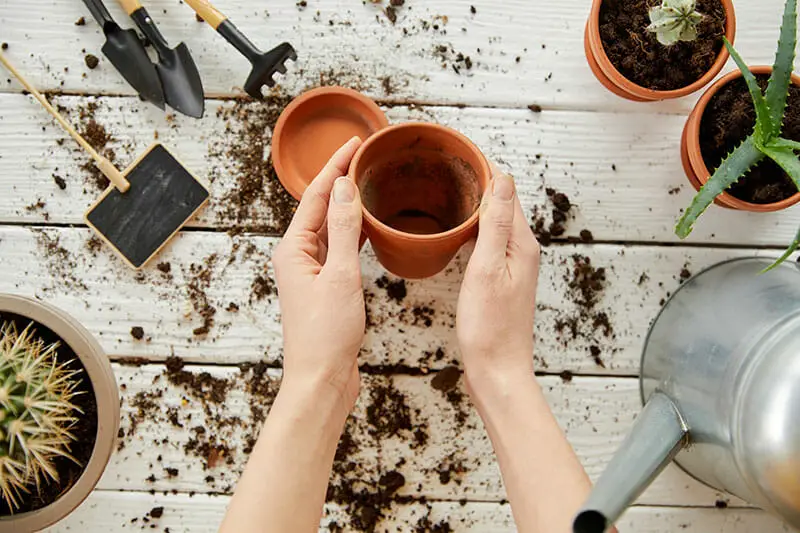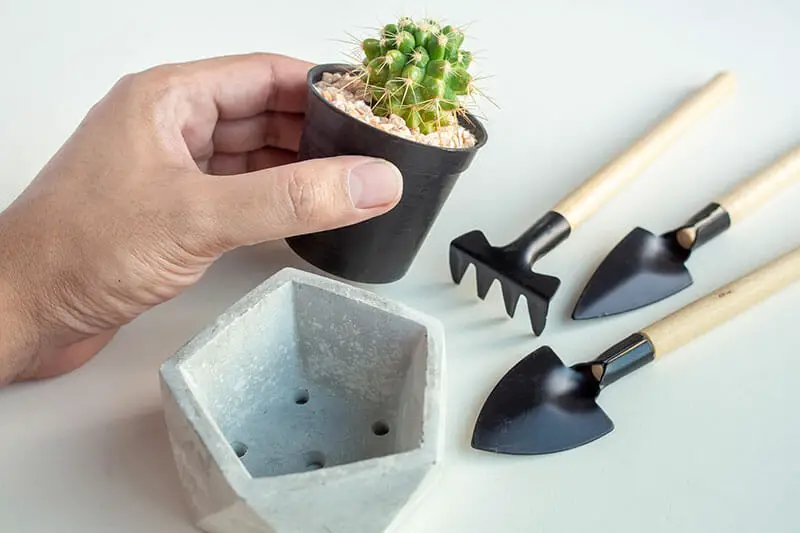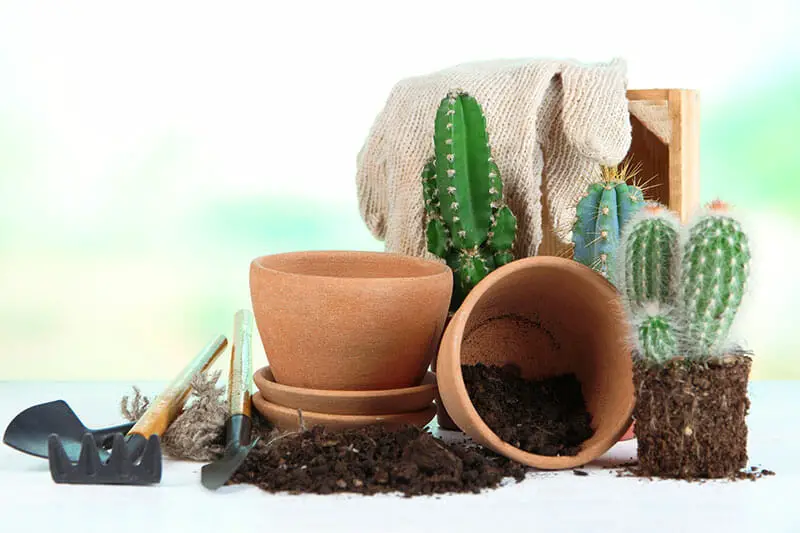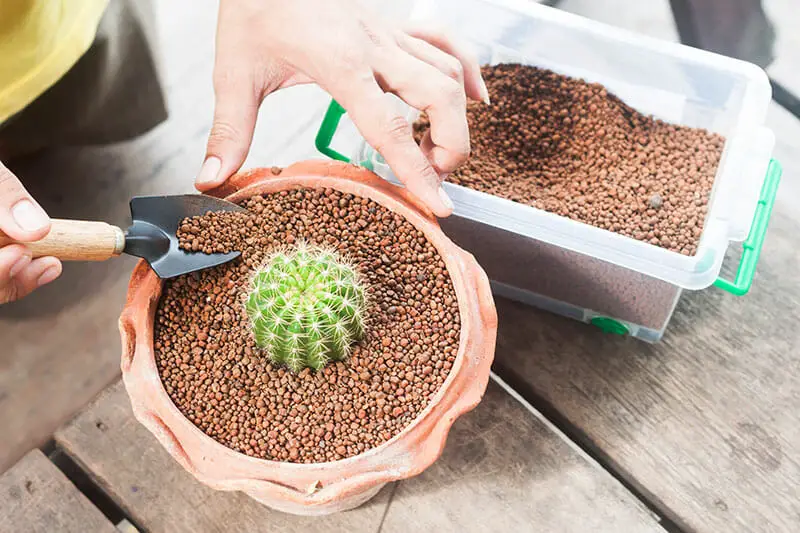
Have you ever been browsing through the potting soils and compost mixes at the local garden center and wondered what exactly makes that “cactus mix” different from all the rest? Actually, there are quite a few things!
What is the difference between cactus soil and potting soil?
In general, cactus soil is designed to mimic a cactus’ natural environment, which is typically dry and nutrient poor.
But just sticking your cactus in a pot full of sand isn’t a recipe for a healthy plant. Here’s what you should know about cactus soil.
Do I Really Need Special Soil?
If you want your cactus to thrive, then yes.
The biggest issue with cacti is too much moisture.
Their roots are shallow and fragile, and can easily succumb to root rot if their potting soil stays too moist.
Even making sure you water lightly and occasionally won’t help if the soil is holding onto every bit of moisture it can—even high humidity can cause problems with some potting soils!
So if you’ve tried raising cacti before and run into issues, try swapping out your soil for something specifically cactus-friendly. You might be surprised what a difference it makes!

We recommend this organic cactus mix. Designed for cacti, you should not experience any problems with this cactus soil.
- Helps retain moisture and improves aeration
- All natural, organic cactus mix
- Adjusted pH
The Five Major Differences
Potting soil mixes can vary greatly depending on the manufacturer and what the soil is intended to do, but in general, soil designed specifically for cacti stands out.
There are five major reasons why:
1. Reduced Moisture Content

As I’ve already mentioned, the biggest difference between cactus soil and regular potting soil is the need for moisture.
Most potted plants can tolerate staying a bit damp, as long as they’re not constantly soggy.
In fact, some plant mixes even include extra hydrophilic (water-loving) components that grab and hold onto extra water, helping plants stay perky between waterings.
But that would be a death sentence for desert-dwelling cacti, which are used to occasional dousings during the rainy season, followed by weeks or months of no water at all.
Cactus soil for potted plants helps mimic this by ditching some of the hydrophilic materials in favor of non-absorbent options like perlite and grit.
However, it’s important to note that while you want to reduce the moisture content in cactus soil, you don’t want to eliminate it entirely.
Though the cactus can probably survive if not completely neglected, allowing the pot to entirely dry out and remain dry causes several problems.
First, it can cause the soil to compact, making it tough for the cactus to send out new roots.
Cacti have very shallow root systems already, so making it difficult for these to expand can be a real detriment to the plant’s growth and health.
Secondly, it can make it difficult to properly water your cactus later.
Soil that has completely dried and compacted tends to allow water to simply run off instead of soaking in.
While cacti do have highly efficient root systems capable of taking in water quickly, these are designed for rainstorm-length events in the desert, not a quick pass with a watering can on Tuesday afternoon.
This is one reason why simply planting your cacti in sand doesn’t yield good results.
Ideally, you want a soil that will hold just enough moisture to keep from solidifying without feeling damp.
2.Less Organic Matter

Though cactus soil might be mostly inorganic materials like rock and sand, it will also contain a small amount of organic material to promote plant growth, hold onto a bit of moisture, and break up the soil a bit.
Organic matter refers to anything that was once alive, like compost, peat moss, coconut coir, wood chips, and basically anything else that’s not rock or sand.
These materials are what plants use for nutrients, after they’ve been broken down by critters like insects and bacteria.
In a potted plant, there’s typically very little insect action going on, so organic materials can take a long time to break down.
That’s why lots of potting mixes also include more accessible nutrients, like fertilizer preparations or compost, which is organic material that’s already started breaking down.
Cacti, on the other hand, aren’t used to rich soils, so mixes developed specifically for them tend to leave out much (but not all!) of the organic material.
3. Fewer Nutrients

As you might have guessed from the “less organic matter” section above, cactus soil is typically nutrient poor.
Not only does it lack the broken down organic matter that other soils rely on, it will typically also lack any additional fertilizers, like the nitrogen, phosphorus, and potassium salts that typically make up dissolvable fertilizer crystals and pellets.
Other types of plants would be absolutely miserable in such poor soil, but for slow-growing cacti used to sandy deserts, it’s perfect.
Too many nutrients can actually cause “burning,” or damage to the plant, or unhealthy overgrowth as the plant tries to put all the food to use before it’s gone.
Instead of rich potting soil, opt to feed your cacti with occasional doses of water-soluble fertilizer or compost tea.
Your cactus plants will do best when fed lightly in the spring as they start to come out of their dormant phase, and, if they’re some of the faster growing varieties, perhaps again in the summer.
Don’t feed in winter, when your cactus is dormant, as it won’t be able to put these nutrients to use, and never overfeed!
If you’re not sure whether your cactus has had fertilizer recently, err on the side of caution and let it go until spring.
4. Better Aeration
Well-aerated soil is one thing that sets commercially developed cactus soils apart from cacti’s natural environment.
Desert soil often ends up compacted and dense, making it tough for cacti to grow and spread.
Aerated cactus soil for potted specimens, on the other hand, makes it easy, which can speed up growth, flowering, and, for varieties that multiply, you may even see more little baby cacti forming!
What makes for well-aerated soil?
For cacti, a high percentage of inorganic materials, like rock and grit.
Specifically, you want lightweight, fluffy materials. Perlite and pumice are two excellent options.
These are both naturally occurring types of stone that are very porous, which makes them very lightweight for stone.
They encourage airflow in soil and hold just enough water to help keep the soil around them from becoming tightly compacted.
5. Better Drainage

This one might seem like another no-brainer, especially after #1 on the list here, but it’s actually very specific.
The drainage properties of a soil actually have more in common with aeration than moisture content, because drainage is about how well water circulates rather than how much sticks around.
With cactus soils, you want excellent drainage so that the water-holding parts of your soil don’t end up like a sodden sponge, holding too much water and causing rot.
You can create well-drained soils several ways. First, the soil itself should have a relatively low percentage of soakable hydrophilic materials like peat moss or wood shavings.
It should have a high percentage of lofty, relatively non-absorbent material like perlite, rough grit, or even small stones.
All of these help keep liquid moving through the planter as you water.
The way you use your soils also matters.
You should always make sure the container you’re planting has drainage holes; this is doubly important for growing cacti.
Add a layer of stones or pea gravel to the bottom of the pot. This will keep those drainage holes from becoming blocked with soil.
Making Your Own Cactus Soil
There are lots of specific recipes for different, but in general, you want a blend of lightweight materials that don’t hold much water, such as sand, pumice stone, or perlite, paired with a small amount of organic matter, like peat moss or coconut coir, that will keep just enough moisture in the mix to prevent it from completely drying out and solidifying.
In a pinch, you can even take leftovers from a bag of regular potting mix and blend it with your sand and perlite for your own cactus soil.
Make sure not to use too much potting soil, and avoid using compost mixes like leaf mold or manure, as these will be much too nutrient rich.
As you’re blending up your soil, keep in mind that cactus soils will look much lighter in color than most potting mixes you might be used to.
Not All Cacti Grow the Same
One reason you may want to make your own cactus soil rather than picking some up at the store is because not all cacti have the same needs.
Some need slightly more moisture, while others need a light and airy mix.
Some epiphytes, or “air plant” cactus varieties might prefer to sit on a bed of wood chips, if it’s usually found growing on trees in nature.
Some tropical cactus plants might even need regular potting soil!
Check the requirements of each variety you’re looking to cultivate to see if any of them call for something extra particular.
Cacti are a versatile family of plants.
Though they can be particular when it comes to their living arrangements, once you’ve got them settled in the right soil, they’re easy to please.
Do you have a favorite DIY recipe for cactus soil? How about tips for troubleshooting finicky varietals? Share your wisdom in the comments!
Hello, My name is L.J.
I have had this orcid cactus for 4 years and no flowers. It is an indoor here in Canada. Recently I finally bought some cactus soil and changed it all up. I hope this works. I am going to put the plan into action by watering at certain times. Which I never did before.
So how often do you think it will need watering? Looking forward to your help.